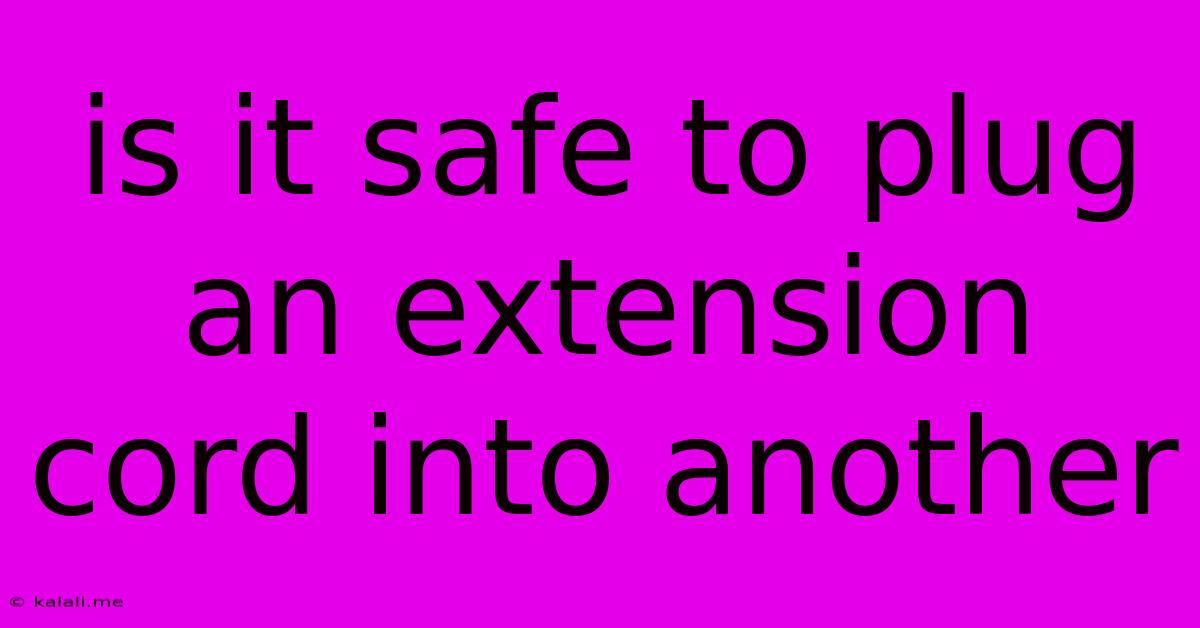Is It Safe To Plug An Extension Cord Into Another
Kalali
May 20, 2025 · 3 min read

Table of Contents
Is It Safe to Plug an Extension Cord into Another? A Comprehensive Guide
Plugging one extension cord into another, often called "daisy-chaining," is a common practice, but is it safe? The short answer is: it depends. While it's not inherently dangerous, doing so improperly can create significant fire hazards and electrical risks. This guide will walk you through the safety considerations and best practices to ensure you're using extension cords safely.
Meta Description: Learn about the safety risks of plugging extension cords together and discover best practices for safe extension cord usage to avoid electrical hazards and fire risks.
Understanding the Risks of Daisy-Chaining Extension Cords
The primary concern with plugging multiple extension cords together lies in increased resistance and heat buildup. Each cord adds resistance to the electrical flow, leading to a higher temperature. This is particularly dangerous if the cords are overloaded, meaning they're drawing more power than they're designed to handle. Excessive heat can melt the cord's insulation, potentially causing a short circuit and fire.
Other risks include:
- Tripping hazards: A tangle of extension cords can create a tripping hazard, especially in high-traffic areas.
- Damage to appliances: Voltage drops caused by excessive resistance can damage sensitive electronic equipment.
- Grounding issues: Improper grounding can lead to electric shock.
Safe Practices for Using Extension Cords
To minimize risks, follow these guidelines:
-
Check the gauge: The gauge of an extension cord refers to the thickness of its wire. A lower gauge number (e.g., 14-gauge) indicates thicker wire and a higher current carrying capacity. Thicker gauge cords are safer for higher-wattage appliances. Use the appropriate gauge for the appliance's power requirements. Never use a cord with a gauge lower than what is recommended for the device's wattage.
-
Don't overload the circuit: The total wattage of all appliances plugged into an extension cord should not exceed the cord's rated wattage. Check the cord's label for its maximum wattage rating. Similarly, avoid overloading the wall outlet's circuit.
-
Inspect cords regularly: Look for signs of damage such as fraying, cracks, or exposed wires. Damaged cords should be replaced immediately. Regular inspection is crucial for safe operation.
-
Use only indoor or outdoor cords appropriately: Using an indoor cord outdoors or vice-versa can result in damage and electrical hazards. Only use cords specifically rated for outdoor use in wet or damp conditions.
-
Avoid using multiple adapters: Combining multiple adapters with extension cords significantly increases the risk of overload and fire. Avoid using extension cords and power strips together if it exceeds the safe wattage threshold.
-
Choose the right length: Use the shortest extension cord necessary to avoid excessive resistance. Longer cords have higher resistance and are more likely to overheat.
-
Keep cords away from heat and moisture: Avoid placing cords near heat sources or in areas where they may get wet. Prolonged exposure to moisture can damage the insulation and create a fire hazard.
-
Unplug cords when not in use: Avoid leaving appliances plugged into extension cords unnecessarily. This minimizes the risk of electrical hazards and prolongs the cord's lifespan.
When Daisy-Chaining Might Be Acceptable (with Caution)
There are rare instances where daisy-chaining might be acceptable, but only under strict conditions. For example, using two heavy-duty, appropriately-gauged extension cords to power a single, high-wattage appliance might be tolerable if the total length is short, the combined wattage does not exceed the cord ratings, and the cords are in good condition. However, this is a situation best avoided if possible.
Ultimately, the safest approach is to avoid daisy-chaining extension cords whenever feasible. Utilizing power strips with surge protection or installing additional outlets is often a safer and more practical solution.
By following these safety guidelines, you can minimize the risks associated with using extension cords and create a safer environment for yourself and your family. Remember, prevention is always better than cure.
Latest Posts
Latest Posts
-
Did Voldemort Know Harry Was A Horcrux
May 20, 2025
-
How Can We Separate Oil And Water
May 20, 2025
-
Difference Between 0w 30 And 5w 30
May 20, 2025
-
What Are Try Squares Used For
May 20, 2025
-
Can You Cook Frozen Ground Meat
May 20, 2025
Related Post
Thank you for visiting our website which covers about Is It Safe To Plug An Extension Cord Into Another . We hope the information provided has been useful to you. Feel free to contact us if you have any questions or need further assistance. See you next time and don't miss to bookmark.